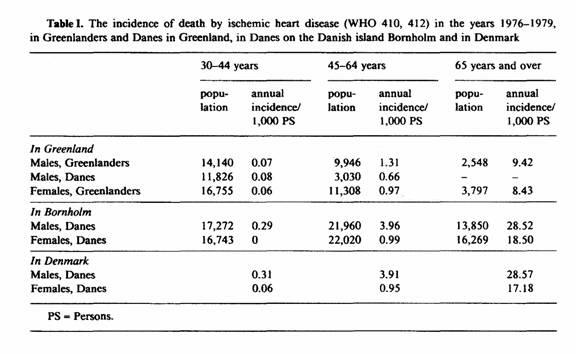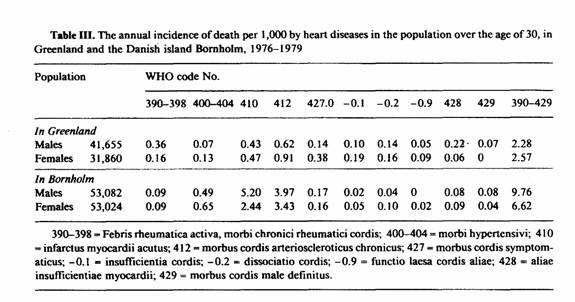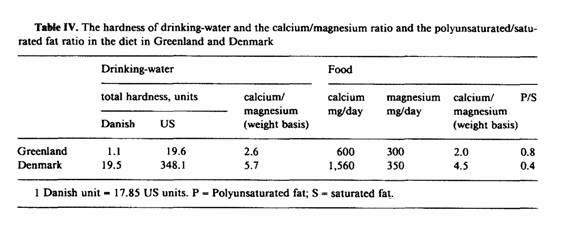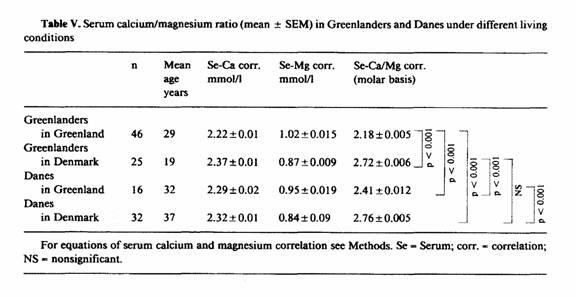Magnesium 6:307-313;(1987)
Greenland, a Soft-Water Area with a Low Incidence of Ischemic
Heart Death
Bjarne Bo Jeppesen
Sæby Hospital, Høng, Denmark
Key Words. Greenland · Soft-water area
· Ischemic heart death · Calcium/magnesium
ratio
Abstract. Present-time Greenlanders are
living a stressful ‘westernized life’ complete with
an elevated consumption of tobacco and alcohol. The drinking
water in Greenland is extremely soft and the diet is very low
in calcium (and probably magnesium) and rich in carbohydrate
and fat. Despite these different predisposing factors, death
from ischemic heart disease is 3-6 times less frequent than in
Denmark. The serum calcium/magnesium ratio in Greenlanders is
significantly lower than in Danes. Magnesium deficits in
patients with acute myocardial infarction, as well as
epidemiologically positive correlations between dietary
calcium/magnesium ratios and ischemic heart death, are the
basis for attributing the low incidence of ischemic heart death
in Greenland to the low Greenlandic calcium/magnesium ratio in
diet and blood serum. Other characteristics of the Greenlandic
disease pattern include a low incidence of stones in kidney and
urinary tract, few cases of diabetes mellitus, prolonged
bleeding time, increased atrioventricular block and
osteoporosis, all of which may also be related to a low calcium
and high magnesium metabolic status.
2. Introduction
Factors predisposing to ischemic heart disease such as stress,
smoking, alcohol, lack of physical activity, a high dietary
carbohydrate and fat intake are to a high degree present in the
Greenlandic daily life [3, 8, 10]. The Greenlandic drinking water
is surface water and therefore soft, which further increases the
risk for ischemic heart disease [23]. Nevertheless, ischemic
heart disease appears to be less frequent in Greenland than in
Denmark, although past studies have not taken age and sex factors
into consideration [2, 3, 10, 17].
Deficiency in magnesium content in patients with acute
myocardial infarction has been described [14], and a positive
correlation has been shown epidemiologically between the dietary
calcium/magnesium ratio and ischemic heart death [15]. The low
serum calcium and high serum magnesium, shown earlier in
Greenland residents [12, 12] might therefore be the cause of a
lower incidence of ischemic heart disease [22].
The purpose of the present study is to determine the influence
of age and sex factors on the incidence of ischemic heart death
in Greenlanders as well as in Danes who live in Greenland, also
to estimate the hardness of the Greenlandic drinking water, the
calcium and magnesium content in the water and the diet, and to
relate the serum calcium/magnesium ratio to the incidence of
ischemic heart disease as well as other Greenlandic disease
patterns [2, 3, 9, 11, 13, 17].
Materials and Methods
Materials
The incidences of ischemic heart disease in Greenland and in
Bornholm were compared during the period 1976-1979 [25, 26].
Bornholm is the Danish county most resembling Greenland in terms
of size of population and its relatively isolated position [7].
The populations of both islands are concentrated in small town
communities along the coast, where fishing and related industries
play an important role.
Climatically, Greenland belongs to the Arctic area, while
Bornholm with its position in the Baltic has a temperate climate
favoring agriculture. The Danish National Board of Health
administers both islands and the criteria for death certificate
diagnoses are identical. The Greenlandic Health Service is
decentralized consisting of well-educated Danish doctors along
the Greenlandic coast, each town having its own hospital. In
Greenland there are 11 hospital beds, 11 nurses and 1 doctor per
1,000 inhabitants, while in Bornholm there are 4 hospital beds,
12 nurses and 2 doctors per 1,000 inhabitants. The public
expenses for the health services are equal, i.e. 3,900 Danish
crowns/inhabitant [5]. Due to lower requirements for
hospitalization, most diagnoses appear with double incidence in
Greenland compared to Denmark.
For Greenland, analyses of the drinking water are mean values
obtained from the waterworks in Nuuk/Godthåb during the
years 1978-1983 [16]. For Bornholm, the analyses of the water are
mean values from several waterworks for the year l983 [6]. The
intake of calcium and magnesium and the ratio of saturated and
polyunsaturated fat in Greenlandic and Danish food were compared
[ 10, 21]. The food intake in Greenland (Angmagssalik) from the
year 1979, with a monopoly of European food import, made this
statistic quite precise.
In Greenland, blood for serum analysis was taken from healthy
males, 46 Greenlanders and 16 Danes living in NuuklGodthåb.
In Denmark, the blood serum was obtained from 25 male Greenlandic
boarding-school pupils, who had resided for at least 6 months in
Denmark, and also from 32 Danish males at the ear-nose-throat
outpatients’ clinic in Slagelse. Further detailed
information about each group has been presented earlier [11,
12).
Methods
The criterion for heart disease as a cause of death was a
death certificate, where the primary cause of death was one of
the following WHO code numbers: 390-398, 400-404, 410-414, or
420-429. Autopsies are rarely performed in Greenland, whereas the
causes of death in Bornholm are frequently autopsy-verified.
The hardness of the drinking water was determined by the
content of calcium and magnesium and is defined by a Danish unit:
10 mg CaO in 1 liter of water or 7.19mg MgO in 1 liter of water.
A Danish unit is equivalent to 17.85 USA hardness units. Very
soft water has <29 US units, very hard water > 250 US
units.
Serum calcium was determined by titration fluorometry (Corning
Calcium Analyzer 940) with an allowed deviation of 0.04 mmol/l in
double analyses. Serum calcium was corrected for serum albumin
deviations from an albumin concentration of 45 g/l by the
equation:
Serum calcium correlation (mmol/l)= [serum calcium observed,
mmol/l] + 0.0163 (45-[albumin observed, g/l]).
Reference range equalled 2.20-2.50 mmol/l.
Serum magnesium was determined by nuclear absorption
photometry (Zeiss FL Electrolyte Automate) with an allowed
deviation of 2.5% in double analyses.

Serum magnesium was corrected for serum albumin deviations
from an albumin concentration of 45 g/l by the equation:
Serum magnesium correlation (mmol/1) = [serum magnesium
observed, mmol/l] + 0.007 (45-[serum albumin observed, g/l]).
Reference range equalled 0.70-0.95 mmol/l.
Serum albumin was determined photometrically by bromocresol
green (L.K.B. filter photometer 2074) with an allowed deviation
of 2 g/l in double analyses. Reference range equalled 42-50 g/l.
Student’s t test was used for determination of statistical
significance.
Results
The incidence of ischemic heart death (WHO 410, 412) in
Greenland and in Bornholm is shown in table I. The death rate for
males is 3-6 times higher in Bornholm. In Greenland the death
rate for ischemic heart disease for males in the age group 45-64
years is 3 times as high for Greenlanders compared with Danes
living in Greenland.
The incidences of acute myocardial infarction (WHO 410) and
morbus cordis ischaemicus chronicus (WHO 412) are given in table
II. Acute myocardial infarction for males is 4 times lower in
Greenland for the age group of 30-44 years (table II); when
subjects reach the age 45-64 years, the incidence has increased
by a factor of 20 in both Greenland and Bornholm. Morbus cordis
ischaemicus chronicus is 3 times lower for the age group of 30-44
years in Greenland, but its incidence increases with age by a
factor 7 in both Greenland and Bornholm. The mortality rates for
different heart diseases and for heart diseases as a whole are
shown in table III. It can be seen that no significant
male:female difference in the incidence of ischemic heart death
(WHO 410) is evident in Greenland.


The hardness of the drinking-water, the daily intake of
calcium and magnesium and the polyunsaturated/saturated fat ratio
are shown in table IV. The water is extremely soft in Greenland
and the calcium/magnesium ratio (weight basis) in food is half
compared to the calcium/magnesium ratio in Denmark. The blood
serum calcium/magnesium ratio (molar basis) within the individual
population groups is shown in table V. The lowest serum
calcium/magnesium ratio is seen in Greenlanders in Greenland, and
the highest in Danes in Denmark. Greenlanders in Denmark
presented the second highest serum calcium/magnesium ratio, which
is not significantly different from that of Danes in Denmark. The
Danes in Greenland take up a position in between.
Discussion
The population in Greenland is exposed to many of the stress
factors that by tradition are regarded as predisposing to
ischemic heart disease. The use of cigarettes in Greenland per
inhibitant above 15 years of age is 10 cigarettes a day [8]. The
intake of alcohol is 50% higher than in Denmark [8]. The blood
pressure levels in Greenlanders do not, however, appear to be
different from the levels in Danes [4], although the incidence of
death from hypertension are lower in Greenland (table III).


Heart disease is the third most frequent cause of death in
Greenland following accidents and malignancies [3]. Back in 1933,
attention was drawn to a beginning calcium deficit in
Greenlanders [24]. Old Greenlandic provisions rich in calcium and
vitamin D were increasingly replaced by ‘shop food’,
lacking in calcium. Also, today dairy products, fresh fruit and
vegetables are only a small part of the Greenlandic diet [10]. An
increased incidence of osteoporosis and cataract could be
explained by a low calcium intake.
It is a clinical experience that angina pectoris is rare in
Greenland [3]. The remaining Greenlandic pattern of diseases is
characterized by a low incidence of stones in kidney and urinary
tracts, an extremely low incidence of diabetes mellitus and
prolonged bleeding time [2, 3, 13].
Magnesium is thought to exert a therapeutic effect on angina
pectoris [19]. Magnesium with its negative inotropic and
calcium-antagonistic effects is regarded as a natural calcium
antagonist [1a, 27]. The deficit of magnesium is suspected of
playing a role in acute myocardial infarction [1b, 14, 22]. A low
serum calcium and a high serum magnesium value are presumed to
reduce the risk of stones in kidney and urinary tract [13]. A
deficit of magnesium is prevalent in diabetes mellitus [18, 20].
In Greenland a calcium intake of 600 mg daily is equal to the
recommended intake in Denmark, where the calicum intake is double
this amount [21].
It is concluded that the prevalence of age-corrected ischemic
heart death for males, including acute myocardial infarction, is
3-6 times lower in Greenland than in Denmark. This also applies
to Danes settled in Greenland. The Greenlandic drinking water is
extremely soft, the calcium/magnesium ratio in the diet is half
compared to the ratio in Denmark and, in addition, the
calcium/magnesium ratio in serum is significantly lower (p
<0.001).
The special Greenlandic pattern of disease might,
theroretically, be connected with a low serum calcium and a high
serum magnesium level, which — in turn — might
reflect the dietary intake of calcium and of magnesium. The low
calcium/magnesium ratio in the water, food and serum in Greenland
is, epidemiologically, in accordance with the low ischemic heart
death rate [l5].
A screening of the Greenlandic serum for other minerals, trace
elements, cholesterol and fatty acids might further contribute to
the elucidation of the special Greenlandic disease pattern.
Acknowledgements
The skilful technical assistance of Jørn Otzen, The
Danish National Board of Health, and Mette Madsen, The Danish
Institute for Clinical Epidemiology, is gratefully
acknowledged.
I thank Børge B. Jørgensen, Statens
Seruminstitut, Den Grønlandske Kostskole I Tåstrup,
Anderswænge, Amtshospitalet Vordingborg, and
øre-næse-hals-afdelingen i Slagelse for their
helpful cooperation.
Per Winther Petersen, Jonna Bredholt and Bent Harvald have
given valuable support.
References
1a Altura, B.M.; Altura, B.T.: General anesthetics and
magnesium ions as calcium antagonists on vascular smooth muscle;
in Weiss, New perspectives on calcium antagonists, pp. 131-145
(American Physiological Society, Washington 1981).
lb Altura, B.M.; Altura, B.T.: Magnesium, electrolyte
transport and coronary vascular tone. Drugs 4: suppl. 1,
pp. 120-142 (1984).
2 Bang, H.O.; Dyerberg, J.: The lipid metabolism in
Greenlanders. Meddr. Grønland Man. R. Soc. 2:
3-18 (1981).
3 Bennike, T.: Disease and health aspects under Equator and
the Polar circle; in Circumpolar Health 81, pp. 229-240 (NOSAMF,
Oulu 1982).
4 Bjergager, P.; Kroman, N.; Thygesen, K.; Harvald, B.: Blood
pressure in Greenland eskimos. Ugeskr. Læg. 142:
2278-2280 (1980).
5 Bjerregaard, P.; Bille, H.: Sundhed for alle år 2000,
Danmark, Færøerne og Grønland. Ugeskr. Leg.
146: 1887-1889 (1984).
6 Dansk Vandteknisk Forenings Sekretariat:
Vandforsyningsstatestik 1983, 60 Vilh. Becks Vej, DK- 8260 Viby
J. (Denmark).
7 Grønlands befolkning, 1. april 1976, 1. januar
1977-1979 og statistisk tabe1værk 1978: II,
København 1978, 11 Sejerøgade, Postbox 2550,
DK-2100 København Ø (Denmark).
8 Grønland, Kalaallit Nunaat, 1980, Årsberetning
udarbejdet af ministeriet for Grønland, tabel 87,
116 (11. årgang 1981).
9 Harvald, B.; Hels, J.: Congenital malformations in
Greenlandic Eskimos. Ugeskr. Læg. 132: 919-924
(1970).
10 Helms, P.: Changes in disease and food patterns in
Angmagcsalik, 1949-1979; in Circumpolar Health 81, pp.
243-251 (NOSAMF, Oulu 1982).
11. Jeppesen, B.B.; Harvald, B.: Serum calcium in Greenland
Eskimos. Acta med. scand. 214: 99-101 (1983).
12 .Jeppesen, B.B.; Blach, A.; Harvald, B.: Serum magnesium in
Greenland Eskimos. Acta med. scand. 215: 477-479
(1984).
13 Jeppesen, B.B.; Lynge, P.; Harvald, B.: Urinary calculi in
Greenland Eskimos. Arctic med. Res. 37: 30-33
(1984).
14 Jeppesen, B.B.: Magnesium status in patients with acute
myocardial infarction: a pilot study. Magnesium 5:
95-100 (1986).
15 Karppanen, H.: Epidemiological studies on the relationship
between magnesium intake and cardiovascular disease. Artery
9: 190-199 (1981).
16 Klinisk Vandanalyse. Dons R. Vanthnalytisk laboratorium,
Grønlands tekniske organisation, 20 Hauser Plads. DK-l
127, København K (Denmark).
17 Kromann, N.; Green, A.: Epidemiological studies in the
Upernavik district, Greenland. Acta med. scand. 208: 40
1-406 (1980).
18 Levin, G.E.: Mather, H.M.; Pilkington, T.R.E.: Tissue
magnesium status in diabetes mellitus. Diabetologia 21:
131-134 (1981).
19 Makiel-Shapiro, B.; Bersohn, I.; Terner, P.E.: Parenteral
magnesium phosphate therapy. Med. Proc. 2: 455-46 1
(1956).
20 Mellerup, E.T.: Insulin effects on calcium, magnesium and
phosphate metabolism in rats. Acta endocr. 75: 748-755
(1974).
21 Levnedsmiddeltabeller og danskeres kostvaner 1985. I.
Hovedresultater, No. 75 (Copenhagen 1985).
22 Seelig, M.; Heggtveit, A.: Magnesium interrelationships in
ischaemic heart disease. A review. Am, J, clin. Nutr.
27: 59-79 (1974).
23 Stitt, F.W.; Clayton, D.G.; Crawford, M.D.; Morris J.N.:
Clinical and biochemical indicators of cardiovascular disease
among men living in hard and soft water areas. Lancet i:
122-126 (1973).
24 Sundhedsstyrelsens Aarsberetning for 1933 XX: 106-107
(København 1934). The Danish National Board of Health, 1.
St. Kongensgade, DK-1264 København. K. (Denmark).
25 The Danish Institute for Clinical Epidemiology, 25
Svanemøllevej, DK-2 100 København Ø
Denmark).
26 The Danish National Board of Health, 1. St. Kongensgade,
DK-1264 København K. (Denmark),
27 Turlapaty, P.D.M.V.; Altura, B.M.: Magnesium deficiency
produces spasms of coronary arteries: relationship to etiology of
sudden death ischemic heart disease. Science 208:
198-200 (1980).
Received: September 2, 1986
Accepted: September 8, 1987
Bo Jeppesen
Tjørnelundevej 17
Tjørnelunde
DK-4270 Høng (Denmark)
This page was first uploaded to The Magnesium Web Site on
August 15, 2002
http://www.mgwater.com/





